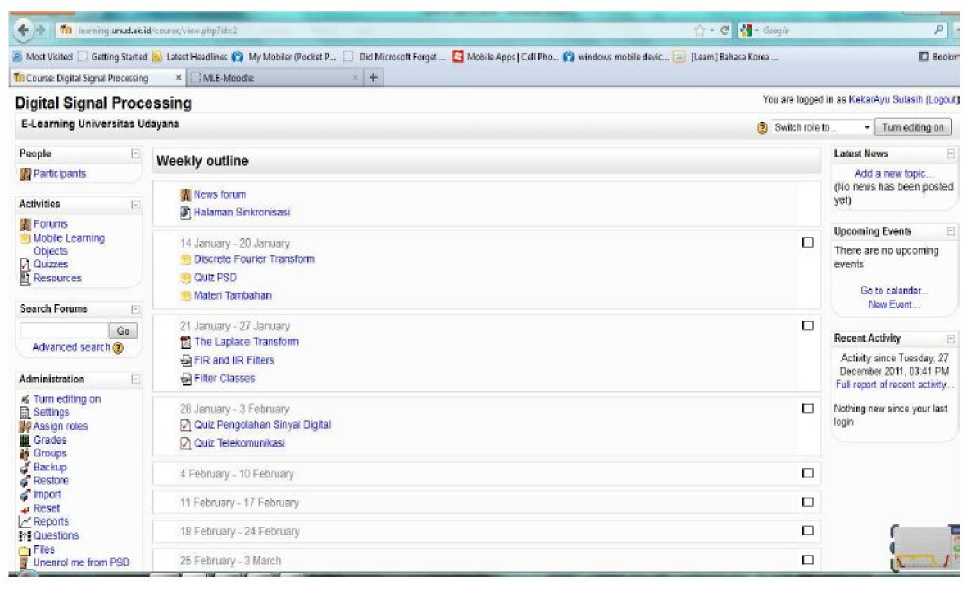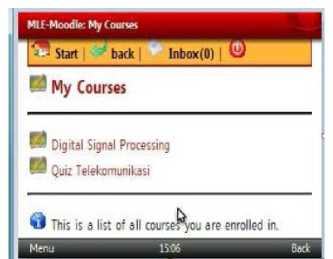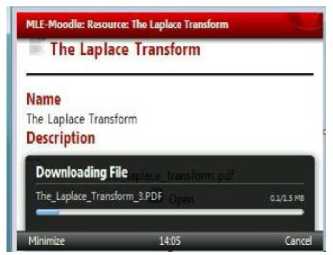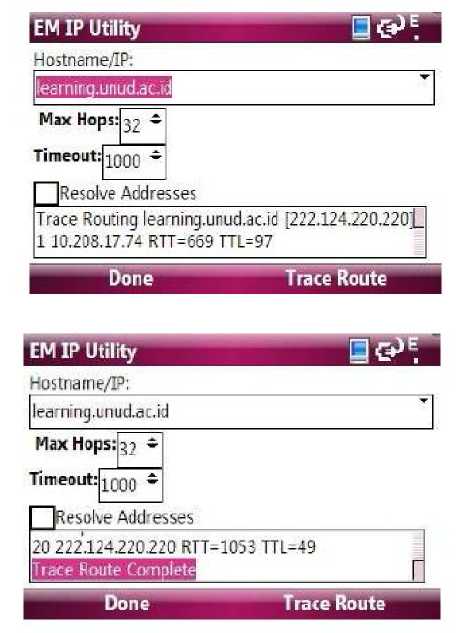PERFORMANCE of MOBILE LEARNING on GPRS NETWORK
on
Performance of Mobile Learning on …
Linawati
PERFORMANCE of MOBILE LEARNING on GPRS NETWORK
Linawati
Electrical Engineering Department, Udayana University,
Kampus Bukit Jimbaran, Bali, 80361
Indonesia linawati@unud.ac.id
Abstract
Mobile learning becomes new life style in modern era. In view of the fact that mobile phone turns into basic need of people. However most people live in rural area only affords cell phones with General Packet Radio Service GPRS facilities. Yet telecommunication infrastructure in rural area does not support 3G facilities. Therefore the paper investigates performance of mobile learning in GPRS network. The purpose of the paper is to enlarge elearning facilities to people with GPRS facilities. Overall the paper shows that good performance of mobile learning in GPRS network. The results present excellent packet loss and good delay. However throughput is slightly poor.
Key words: Mobile learning. GPRS, 3G
Mobile learning (m-learning) can be used as an alternative media in learning process. This is supported by fact in Indonesia that number of cell phones increases significantly [1], and dominant is owned by youngsters. Indonesia has 6th rank in the world for mobile phone users. In the big cities in Indonesia, smart phones are people choice. However most people in the rural area, small cities and remote areas in Indonesia with little income, just afford to have cell phones with GPRS facilities. On the other hand, only people in urban areas can use laptop to access Internet and e-learning.
Moodle (Modular Object Oriented Dynamic Learning Environment) is e-learning open source software. Moodle provides many features which is needed by learning process. Mobile Learning Engine (MLE) is one of Moodle plug-ins for mobile learning. Therefore MLE Moodle can be accessed by mobile/cell phones [2]. Learning material, such as ebook, quiz, multiple choice, essay, etc can be accessed.
Paper [3] analyzes from both learning and technological perspectives, the development of learning applications using mobile devices. To this end, proxy and proxy less architectures are considered as way to extend traditional virtual campuses with mobile clients. The research has two objectives, i.e. to access learning materials and to support learning activities. A prototype of a Virtual Campus was developed using MLE-Moodle -the Mobile Learning module of Moodle. Literature review that deals with the definition of mobile learning, distinguishing it from traditional e-learning are presented in [4]. It also discusses the affordances and constraints of mobile learning, and addresses how mobile learning is being deployed as a supplement to traditional learning or in addition to a classroom. In addition the paper reviews the learning
theories that are addressed in the literature, as well as the strategies employed for mobile learning development. Finally the paper reveals some of the gaps in research literature.
Quality of Service (QoS) is one indicator for m-learning performance, especially run on GPRS network [5, 6]. Generally, QoS will be analyzed, in term of delay, packet loss and throughput of a network system. The purpose of the paper is to analyze QoS of mobile learning that is run on GPRS network. The experiment will utilize Moodle with plug-in MLE-Moodle 0.8.8.3., Moodle e-learning server in Udayana University, WinSCP is a software to access Moodle server, GPRS network of GSM provider Indosat, Opera Mini and Opera Mobile as browsers in mobile phone.
E-learning is learning process that is supported by ICT. E-learning can be distance learning or mobile learning (m-learning). LMS (Learning Management Systems) is an application to support both e-learning and m-learning implementation. Moodle is common open-source LMS that is employed in many education institutions [7- 10]. Accordingly everyone allow to add module or plug-in to improve its capability. MLE – Moodle which is one of Moodle plug-ins, make m-learning implementation possible. MLE – Moodle has all features of Moodle, such as quiz, lesson, assignment, survey and choice or polling, forum, wiki, database, and instant messaging system. Adding features of MLE-Moodle are flashcard trainer, MLO (Mobile Learning Object), Mobile Tags, and mobile community.
GPRS (General Packet Radio Service) is packet switching technology in GSM and it is 2G (second generation) technology in GSM. The performance of the enhancement (E)GPRS connections is very much dependent on the radio conditions (C/I) and on the
available resources for data calls (PDCH) [11]. The radio conditions will determine what coding scheme shall be used, as well as the number of retransmissions that will be caused of bad radio reception. In addition, dimensioning of the network may also force users to share the same TSLs, and the available bandwidth, when traffic load grows. Table 1shows typical throughput in GPRS network.
Quality of Service (QoS) for telecommunication system has been standardized by International Organization such as ITU-T [12 – 13]. However delay standard according to ITU-T G.1010 is less than 15 second for data size of 10 KB to 10 MB and less than 4 second for data size less than 10 KB. Additionally according to ITU-T G.114, maximum packet loss is less than 10% of total sent packet.
Table 1. Typical GPRS and EGPRS RLC throughput per MS class [11]
|
Throughput (kbps) |
Mobile MS class 2 |
Mobile MS class 6 |
Mobile MS class 10 |
|
Configuration |
2 + 1 |
3 + 1 / 2 + 2 |
4 + 1 / 3 + 2 |
|
GPRS | |||
|
Maximum |
40 |
60 |
80 |
|
Typical (CSI – 2) good C/I |
22 |
32 |
42 |
|
Typical (CSI – 2) medium/low C/I |
16/20 |
30/24 |
40 |
|
Typical (CSI – 4) good C/I |
30 |
45 |
60 |
|
Typical (CSI – 4) medium/low C/I |
22/30 |
30/45 |
40/60 |
|
EGPRS | |||
|
Maximum |
118.4 |
177 |
236.8 |
|
Typical good C/I |
100 |
150 |
200 |
|
Typical medium/low C/I |
64/100 |
98/150 |
130/200 |
The experiments have been done in two campuses of Udayana University and in Tabanan Area (off campus). The distance between three locations is around 35 km. According to Google Earth that air distance between Sudirman campus and Jimbaran campus is around 14.42 km, and 16.07 km of distance between Sudirman and Tabanan. The university e-learning which is located in http://elearning.unud.ac.id was accessed using FTP, in WinSCP installed in laptop as a client , and MLE Moodle plug-ins. Course contents in the server such as slides, articles, and quizzes were browsed and downloaded. Browsing and downloading process were part of the experiments. The contents are in pdf, ppt, and mpeg format. Each content has maximum size of 2 MB.
Scenario of the experiments is three clients with different mobile phones to do downloading the contents at the same time. Then delay, packet loss, and throughput are analyzed. Specification of hardware and software are shown in table 2.
Table 2. Hardware and Software Specification
|
Hard ware |
Laptop (Client) |
Samsung Omnia Pro B7320 |
Sony Ericsson W960i |
Sony Ericsson Z555i |
|
Proces sor |
Intel Core i5 2.27 GHz |
ARM113 6EJS 528 MHz |
ARM926E J 208 MHz |
ARM 9 Family 120 MHz |
|
Memo ry |
2048 MB |
173.66 MB |
RAM 128 MB |
12 MB |
|
Hardd isk |
320 GB |
- |
- |
- |
|
Opera ting Syste m |
Window s 7 |
Windows mobile 6.0 |
Symbian OS 9.1 UIQ 3.0 |
Java J2ME |
Three mobile phones run on GPRS of the same operator. They access the e-learning server from three different locations as mentioned above. The network model is shown in Figure 1.

Figure 1. Network Model
Three mobile phones as clients accessed the server from different locations. They downloaded the contents. Figure 2 displays the content in the server and figure 3 shows downloaded content in the mobile phone.
When two clients downloaded the content file of e-learning of 1,540 KB size from three locations, they have different throughput. Average throughput of client 1 is higher than client 2. The differences due to different specification of mobile phones and signal strength. In addition the throughput is below ITU standard of GPRS i.e. 171.2 Kbps. That means the performance is poor as shown in table 3.
Table 3. Throughput of clients with File Size of 1,540 KB
|
Location |
Throughput (bps) | |
|
Client 1 |
Client 2 | |
|
Off Campus |
10807,02 |
11169,54 |
|
Sudirman Campus |
61600,00 |
23968,87 |
|
Jimbaran Campus |
20533,33 |
27017,54 |
|
Ave. throughput |
30980,12 |
20718,65 |
The experiment continued doing quiz in e-learning system. The quiz is multiple choices with 30 questions. Each page has maximum three questions. Some pages have pictures or tables. Figure 4 demonstrates quiz access on mobile phone.
Additionally, table 4 up to table 6 present performance of mobile learning system.

Figure 2. Course content in the server

Figure 3. Accessed e-learning course in mobile browser


Figure 4. Accessing Quiz on mobile phone

Inbox(O)
Quiz Telekomunikasi - Attempt 1
Question i ∣ Marks: -√10
Please fill out all the questions and dick on the Submitbutton on the last page.

Table 4. Delay of two clients in doing quiz in three locations
|
Page No. |
File Size (KB) |
Client Delay (s) | |||||
|
Off Campus |
Sudirman |
Jimbaran | |||||
|
1 |
2 |
1 |
2 |
1 |
2 | ||
|
1 |
14 |
0.0005 |
0.0021 |
0.0011 |
0.0016 |
0.0007 |
0.0014 |
|
2 |
27 |
0.0005 |
0.0006 |
0.0003 |
0.0019 |
0.0005 |
0.0005 |
|
3 |
36 |
0.0006 |
0.0009 |
0.0003 |
0.0022 |
0.0004 |
0.0012 |
|
4 |
5 |
0.001 |
0.0006 |
0.001 |
0.0032 |
0.0004 |
0.0014 |
|
5 |
32 |
0.0003 |
0.0033 |
0.0008 |
0.0003 |
0.0023 |
0.0009 |
|
6 |
6 |
0.001 |
0.0077 |
0.004 |
0.0036 |
0.0015 |
0.0032 |
|
7 |
43 |
0.0003 |
0.0018 |
0.004 |
0.001 |
0.0003 |
0.0006 |
|
8 |
8 |
0.0014 |
0.0016 |
0.0006 |
0.0023 |
0.0017 |
0.0079 |
|
9 |
8 |
0.0015 |
0.0019 |
0.0007 |
0.01 |
0.0016 |
0.0008 |
|
10 |
4 |
0.0027 |
0.0008 |
0.001 |
0.0006 |
0.0006 |
0.0014 |
|
11 |
4 |
0.0015 |
0.0028 |
0.0015 |
0.001 |
0.0025 |
0.0017 |
|
Ave.Delay |
0.001 |
0.0022 |
0.0011 |
0.0025 |
0.0012 |
0.0019 | |
Table 5. Throughput of two clients in doing quiz in three locations
|
Page No |
File Size (KB) |
Client Throughput (bps) | |||||
|
Off Campus |
Sudirman |
Jimbaran Campus | |||||
|
Client 1 |
Client 2 |
Client 1 |
Client 2 |
Client 1 |
Client 2 | ||
|
1 |
14 |
4869.60 |
3200.00 |
5333.33 |
2947.37 |
8000.00 |
3294.12 |
|
2 |
27 |
10800.00 |
8640.00 |
14400.00 |
2160.00 |
9818.18 |
9000.00 |
|
3 |
36 |
9931.03 |
6857.14 |
11076.92 |
3310.35 |
8000.00 |
4645.16 |
|
4 |
5 |
2000.00 |
2000.00 |
4000.00 |
1538.46 |
5714.29 |
1379.31 |
|
5 |
32 |
16000.00 |
2015.75 |
8533.33 |
8000.00 |
3160.50 |
5333.33 |
|
6 |
6 |
4800.00 |
941.17 |
1454.54 |
1920.00 |
3200.00 |
1500.00 |
|
7 |
43 |
13760.00 |
4095.24 |
13230.77 |
3276.20 |
19111.11 |
10117.65 |
|
8 |
8 |
4000.00 |
3368.42 |
5818.18 |
1828.57 |
3368.42 |
853.33 |
|
9 |
8 |
3555.56 |
2560.00 |
5818.18 |
711.11 |
3200.00 |
3555.56 |
|
10 |
4 |
2000.00 |
3200.00 |
2666.67 |
2461.54 |
4000.00 |
1600.00 |
|
11 |
4 |
1523.80 |
2133.30 |
3200.00 |
2666.67 |
2000.00 |
2666.67 |
|
Average |
6658.18 |
3546.46 |
6866.54 |
2801.84 |
6324.77 |
3995.01 | |
Table 6. QoS when three clients downloading file size of
1540 KB
|
Client |
Delay (s) |
Packet Loss (%) |
Throughput (bps) |
|
1 |
0.0004 |
0 |
19870.97 |
|
2 |
0.0005 |
0 |
14807.7 |
|
3 |
0.0013 |
0 |
6324.44 |
|
Average |
0.0007 |
0 |
13667.7 |
There was no packet loss in the experiment. It was confirmed by all testing results. Accordingly in term of the loss, the performance is the best, as it less than 10%. However delay values are different for different clients and locations. All delay values are less than 15 seconds of file size 10 KB up to 10 MB. Thus delay values are categorized good quality. In the same way, throughput values are different for all clients in all locations. The results exhibit that the values are less than 171.2 kbps for GPRS system. Consequently, according to the standard, the performance is classified poor quality.
Differences values of delay and throughput for all clients in all locations are as a result of GPRS signal strength variation and specification of the clients. The signal strength variation can be seen in figure 5 and figure 6 and table 7. According to the specification that client 1 is the most powerful mobile phone and client 3 is the least powerful mobile phone.

Figure 5. Traceroute of Clients
|
I. |
10.159.46.18 |
RTT=I 248 |
TTL=97 |
|
2. |
10.208.21.133 |
RTT=652 |
TTL=97 |
|
3. |
10.208.21.133 |
RTT=612 |
TTL=97 |
|
4. |
10.208.21.138 |
RTT=611 |
TTL=97 |
|
5. |
10.208.21.148 |
RTT=695 |
TTL=97 |
|
6. |
114.4.16.27 |
RTT=605 |
TTL=97 |
|
7. |
202.152.164.218 |
RTT=656 |
TTL=97 |
|
8. |
222.124.220.220 |
RTT=953 |
TTL=49 |
Figure 6. Traceroute output of client in Sudirman Campus
Table 7. Traceroute results in all locations
|
Location |
Air Distance |
Distance client – nearest BTS |
No. of Hop |
|
Off campus |
± 16.07 km |
± 800 m |
16 |
|
Sudirman |
~ 0 km |
± 1.1 km |
8 |
|
Jimbaran |
± 14.42 km |
± 1.2 km |
17 |
The experiment results good performance of mobile learning in GPRS system in term of packet loss and delay. There are no packet loss and 1.3 ms of average delay. However throughput is pretty below than standard quality. The highest throughput that was achieved, was 60 kbps
-
[1] . Adi, A. 2008. M-Learning in Review: Technology, Standard, and Evaluation. Journal of Communication and Computer. Nov. 2008. Volume 5, No. 11. (Serial No. 48). USA
-
[2] . Alja Sulčič and Artesia d. o. o. , Taking Moodle out of the classroom: making learning mobile, context aware and fun, 4th International Conference Proceedings on Moodle., Koper, 21 May 2010
-
[3] . Xhafa, F.; Caballe, S.; Rustarazo, I.; Barolli,
-
L.; Implementing a Mobile Campus Using MLE Moodle, P2P, Parallel, Grid, Cloud and Internet Computing (3PGCIC), 2010 IEEE International Conference on, Issue Date: 4-6 Nov. 2010, pp 207 – 214
-
[4] . Gregg Orr, A Review of Literature in Mobile Learning: Affordances and Constraints, The 6th IEEE International Conference on Wireless, Mobile, and Ubiquitous Technologies in Education, 2010, pp. 107 – 111
-
[5] . Chen, X, et.al., 2004. Theoretical Analysis of GPRS Throughput and Delay, Rutgers University.
-
[6] . Karagiannis, G. 2000. QoS in GPRS. --Ericsson
-
[7] . Kumar S, Gankotiya AK, Dutta K. A comparative study of moodle with other elearning systems. 3rd International Conference
on Electronics Computer Technology (ICECT). 2011; 5; 414-418
-
[8] . Li SY, Yang CY, Hou Y. Study on enterprise training design of MOODLE. International Conference on Computer and Communication Technologies in Agriculture Engineering (CCTAE). 2010; 3: 339-341.
-
[9] . Kazunori Nozawa. To Moodle or not to Moodle: Can It Be an Ideal e-Learning Environment?. DOI=http://www.ps.ritsumei.ac.jp/assoc/policy_ science/183/183_19_nozawa.pdf
-
[10] . Guido Rößling and Andreas Kothe. Extending Moodle to Better Support Computing Education. In the Proceeding of the ITiCSE’09. July 6–9, 2009, Paris, France.
-
[11] . G. Gómez and R. Sánchez, End-to-End Quality of Service over Cellular Networks: Data Services Performance and Optimization in 2G/3G, John Wiley & Sons Ltd, The Atrium, Southern Gate, Chichester, West Sussex PO19 8SQ, England, 2005
-
[12] . ITU-T Recommendation G.114. One-way transmission time, 2003
-
[13] . ITU-T Recommendation G.1010. End-user multimedia QoS categories. 2001
ACKNOWLEDGEMENT
This publication is result of collaboration research work with colleagues and students in EE Department, Udayana University. The authors also thank to Dewi Wirastuti and Ni Putu Kekar Ayu Sulasih for their kind cooperation and supports.
Teknologi Elektro
6
Vol. 11 No. 1 Januari - Juni 2012
Discussion and feedback